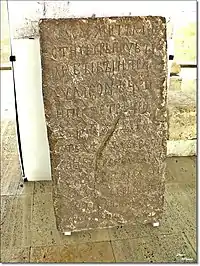Mostich
Mostich (Bulgarian: Мостич, Old Bulgarian: МОСТИЧЬ) was a high-ranking official in the 10th-century First Bulgarian Empire, during the rule of Simeon I and Peter I. He bore the title of Ichirgu-boil and was most likely the commander of the state capital Preslav's garrison.

Mostich is known from the 10th-century Old Bulgarian inscription on his tombstone, found in a church (now known as "Mostich's Church") in the Selishte area of Preslav, then the inner city of the Bulgarian capital. The tombstone was discovered in 1952 by Professor Stancho Vaklinov and is preserved in the National Archaeological Museum.
The inscription is Mostich's epitaph, indicating that he was buried in the church: his remains were also found, revealing that he was relatively short (165–170 cm). The text is notable for being one of the earliest sources mentioning the title "Цѣсарь"[2] ("Tsesar"[3]).
It reads as follows:
сьде лежитъ мо-
стичь чрьгоубъɪ-
ля бъɪвъɪи при
сумеонѣ ц︢ри
и при петрѣ ц︢ри
ос(м)иѭ же десѧ-
ть лѣтъ съɪ оста-
вивъ чрьгоубъɪлъ-
ство ї вьсе їмѣн-
иѥ бъɪстъ чрьнори-
зьць ї въ томь съ-връши жизнь своѭ.[4]
Here lies Mostich, who was ichirgu-boil in the time of Tsar Simeon and Tsar Peter. At age of 80, leaving his post and property behind, he became a monk and so finished his life.[5]
Mostich Hill on Rugged Island in the South Shetland Islands, Antarctica is named after Mostich.
References
- Kodeks - The German Medieval Slavistics Server. Mostič Inscription from Preslav, Bulgaria- Reconstructed, S. Kempgen, 2014.
- Entry for Tsesar in Old-bulgarian dictionary
- Станислав Станилов, Българската монархия през средните векове, Класика и стил, 2003, ISBN 9549964949, p. 69.
- Ст. Станчев, В. Иванова, М. Балан, П. Боев, Надписът на Чъргубиля Мостич, Българска Академия на Науките, 1955, стр. 8.
- Kiril Petkov, The Voices of Medieval Bulgaria, Seventh-Fifteenth Century: The Records of a Bygone Culture, East Central and Eastern Europe in the Middle Ages, 450-1450, BRILL, 2008, ISBN 9047433750, pp. 49-50.
External links
- "Надпис на чъргубиля Мостич от 10 век" (in Bulgarian). Bibliotheca Slavica. 2008-07-27.
- "Надгробен надпис на Мостич — втора четвърт на Х век /копие/" (in Bulgarian). Музей Преслав. 2018-08-18.
